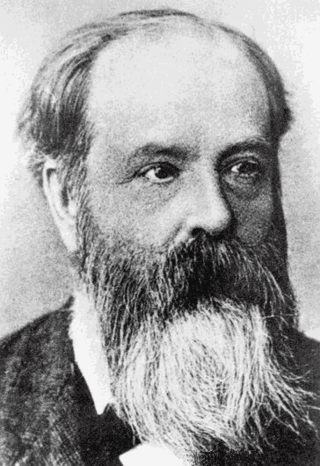
Gustav Robert Kirchhoff was a German physicist, chemist and mathematican who contributed to the fundamental understanding of electrical circuits, spectroscopy and the emission of black-body radiation by heated objects. He also coined the term black body in 1860.

1860 (MDCCCLX) was a leap year starting on Sunday of the Gregorian calendar and a leap year starting on Friday of the Julian calendar, the 1860th year of the Common Era (CE) and Anno Domini (AD) designations, the 860th year of the 2nd millennium, the 60th year of the 19th century, and the 1st year of the 1860s decade. As of the start of 1860, the Gregorian calendar was 12 days ahead of the Julian calendar, which remained in localized use until 1923.

An ironclad was a steam-propelled warship protected by steel or iron armor constructed from 1859 to the early 1890s. The ironclad was developed as a result of the vulnerability of wooden warships to explosive or incendiary shells. The first ironclad battleship, Gloire, was launched by the French Navy in November 1859, narrowly preempting the British Royal Navy. However, Britain built the first completely iron-hulled warships.
The year 1899 in science involved some significant events, listed below.

The year 1820 in science and technology involved some significant events, listed below.
The year 1840 in science and technology involved some significant events, listed below.
The year 1813 in science and technology involved some significant events, listed below.
The year 1862 in science and technology involved some significant events, listed below.
The year 1855 in science and technology involved some significant events, listed below.
The year 1875 in science and technology involved some significant events, listed below.
The year 1898 in science and technology involved some significant events, listed below.

The year 1801 in science and technology involved some significant events, listed below.
The year 1861 in science and technology involved some significant events, listed below.
The year 1859 in science and technology involved some significant events, listed below.
The year 1854 in science and technology involved some significant events, listed below.

Frederick Guthrie FRS FRSE was a British physicist, chemist, and academic author.

Events from the year 1860 in the United Kingdom.

Baroness Frances Waddington Bunsen was a Welsh painter, author and diplomatic hostess, wife of Christian Charles Josias Bunsen, and the older sister of Lady Llanover.
Albert Friedrich Emil Niemann was a German chemist. In 1859 — about the same time as Paolo Mantegazza — he isolated cocaine, and he published his finding in 1860.

Robert Wilhelm Eberhard Bunsen was a German chemist. He investigated emission spectra of heated elements, and discovered caesium and rubidium with the physicist Gustav Kirchhoff. The Bunsen–Kirchhoff Award for spectroscopy is named after Bunsen and Kirchhoff.









